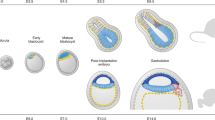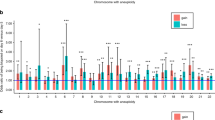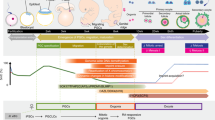Abstract
Human embryonic stem (hES) cells are self-renewing, pluripotent cells that are valuable research tools and hold promise for use in regenerative medicine. Most hES cell lines are derived from cryopreserved human embryos that were created during in vitro fertilization (IVF) and are in excess of clinical need. Embryos that are discarded during the IVF procedure because of poor morphology and a low likelihood for generating viable pregnancies or surviving the cryopreservation process are also a viable source of hES cells. In this protocol, we describe how to derive novel hES cells from discarded poor-quality embryos and how to maintain the hES cell lines.
This is a preview of subscription content, access via your institution
Access options
Subscribe to this journal
Receive 12 print issues and online access
$259.00 per year
only $21.58 per issue
Buy this article
- Purchase on Springer Link
- Instant access to full article PDF
Prices may be subject to local taxes which are calculated during checkout




Similar content being viewed by others
References
Gardner, D.K. & Schoolcraft, W.B. In Vitro Development of Human Blastocyst. (Parthenon Press, Carnforth, 1999).
Racowsky, C. et al. Day 3 and day 5 morphological predictors of embryo viability. Reprod. Biomed. Online 6, 323–331 (2003).
Lerou, P.H. et al. Human embryonic stem cell derivation from poor-quality embryos. Nat. Biotechnol. 26, 212–214 (2008).
Thomson, J.A. et al. Embryonic stem cell lines derived from human blastocysts. Science 282, 1145–1147 (1998).
Reubinoff, B.E., Pera, M.F., Fong, C.Y., Trounson, A. & Bongso, A. Embryonic stem cell lines from human blastocysts: somatic differentiation in vitro. Nat. Biotechnol. 18, 399–404 (2000).
Mitalipova, M. et al. Human embryonic stem cell lines derived from discarded embryos. Stem Cells 21, 521–526 (2003).
Cowan, C.A. et al. Derivation of embryonic stem-cell lines from human blastocysts. N. Engl. J. Med. 350, 1353–1356 (2004).
Zhang, X. et al. Derivation of human embryonic stem cells from developing and arrested embryos. Stem Cells 24, 2669–2676 (2006).
Fong, C.Y., Richards, M. & Bongso, A. Unsuccessful derivation of human embryonic stem cell lines from pairs of human blastomeres. Reprod. Biomed. Online 13, 295–300 (2006).
Klimanskaya, I., Chung, Y., Becker, S., Lu, S.J. & Lanza, R. Human embryonic stem cell lines derived from single blastomeres. Nature 444, 481–485 (2006).
Klimanskaya, I., Chung, Y., Becker, S., Lu, S.J. & Lanza, R. Derivation of human embryonic stem cells from single blastomeres. Nat. Protoc. 2, 1963–1972 (2007).
Chung, Y. et al. Human embryonic stem cell lines generated without embryo destruction. Cell Stem Cell 2, 113–117 (2008).
Nagy, A. Manipulating the Mouse Embryo 3rd ed. (Cold Spring Harbor Press, Cold Spring Harbor, New York, 2003).
Boiani, M., Eckardt, S., Leu, N.A., Scholer, H.R. & McLaughlin, K.J. Pluripotency deficit in clones overcome by clone-clone aggregation: epigenetic complementation? EMBO J 22, 5304–5312 (2003).
Burnside, A.S. & Collas, P. Induction of Oct-3/4 expression in somatic cells by gap junction-mediated cAMP signaling from blastomeres. Eur. J. Cell Biol. 81, 585–591 (2002).
Richards, M., Tan, S.P., Tan, J.H., Chan, W.K. & Bongso, A. The transcriptome profile of human embryonic stem cells as defined by SAGE. Stem Cells 22, 51–64 (2004).
Amit, M. et al. Clonally derived human embryonic stem cell lines maintain pluripotency and proliferative potential for prolonged periods of culture. Dev. Biol. 227, 271–278 (2000).
Pyle, A.D., Lock, L.F. & Donovan, P.J. Neurotrophins mediate human embryonic stem cell survival. Nat. Biotechnol. 24, 344–350 (2006).
Watanabe, K. et al. A ROCK inhibitor permits survival of dissociated human embryonic stem cells. Nat. Biotechnol. 25, 681–686 (2007).
Draper, J.S. et al. Recurrent gain of chromosomes 17q and 12 in cultured human embryonic stem cells. Nat. Biotechnol. 22, 53–54 (2004).
Mitalipova, M.M. et al. Preserving the genetic integrity of human embryonic stem cells. Nat. Biotechnol. 23, 19–20 (2005).
Baker, D.E. et al. Adaptation to culture of human embryonic stem cells and oncogenesis in vivo. Nat. Biotechnol. 25, 207–215 (2007).
Ellerstrom, C., Strehl, R., Noaksson, K., Hyllner, J. & Semb, H. Facilitated expansion of human embryonic stem cells by single-cell enzymatic dissociation. Stem Cells 25, 1690–1696 (2007).
Bajpai, R., Lesperance, J., Kim, M. & Terskikh, A.V. Efficient propagation of single cells accutase-dissociated human embryonic stem cells. Mol. Reprod. Dev. 75, 818–827 (2007).
Xu, C. et al. Feeder-free growth of undifferentiated human embryonic stem cells. Nat. Biotechnol. 19, 971–974 (2001).
Daheron, L. et al. LIF/STAT3 signaling fails to maintain self-renewal of human embryonic stem cells. Stem Cells 22, 770–778 (2004).
Xu, R.H. et al. Basic FGF and suppression of BMP signaling sustain undifferentiated proliferation of human ES cells. Nat. Methods 2, 185–190 (2005).
Yao, S. et al. Long-term self-renewal and directed differentiation of human embryonic stem cells in chemically defined conditions. Proc. Natl. Acad. Sci. USA 103, 6907–6912 (2006).
Bavister, B. Oxygen concentration and preimplantation development. Reprod. Biomed. Online 9, 484–486 (2004).
Ezashi, T., Das, P. & Roberts, R.M. Low O2 tensions and the prevention of differentiation of hES cells. Proc. Natl. Acad. Sci. USA 102, 4783–4788 (2005).
Forsyth, N.R. et al. Physiologic oxygen enhances human embryonic stem cell clonal recovery and reduces chromosomal abnormalities. Cloning Stem Cells 8, 16–23 (2006).
Solter, D. & Knowles, B.B. Immunosurgery of mouse blastocyst. Proc. Natl. Acad. Sci. USA 72, 5099–5102 (1975).
Amit, M. & Itskovitz-Eldor, J. Derivation and spontaneous differentiation of human embryonic stem cells. J. Anat. 200, 225–232 (2002).
Genbacev, O. et al. Serum-free derivation of human embryonic stem cell lines on human placental fibroblast feeders. Fertil. Steril. 83, 1517–1529 (2005).
Ludwig, T.E. et al. Feeder-independent culture of human embryonic stem cells. Nat. Methods 3, 637–646 (2006).
Ludwig, T.E. et al. Derivation of human embryonic stem cells in defined conditions. Nat. Biotechnol. 24, 185–187 (2006).
Richards, M., Fong, C.Y., Chan, W.K., Wong, P.C. & Bongso, A. Human feeders support prolonged undifferentiated growth of human inner cell masses and embryonic stem cells. Nat. Biotechnol. 20, 933–936 (2002).
Richards, M. et al. Comparative evaluation of various human feeders for prolonged undifferentiated growth of human embryonic stem cells. Stem Cells 21, 546–556 (2003).
Richards, M., Fong, C.Y., Tan, S., Chan, W.K. & Bongso, A. An efficient and safe xeno-free cryopreservation method for the storage of human embryonic stem cells. Stem Cells 22, 779–789 (2004).
Scott, L. The biological basis of non-invasive strategies for selection of human oocytes and embryos. Hum. Reprod. Update 9, 237–249 (2003).
Racowsky, C. et al. The number of eight-cell embryos is a key determinant for selecting day 3 or day 5 transfer. Fertil. Steril. 73, 558–564 (2000).
Check, J.H., Summers-Chase, D., Yuan, W., Horwath, D. & Wilson, C. Effect of embryo quality on pregnancy outcome following single embryo transfer in women with a diminished egg reserve. Fertil. Steril. 87, 749–756 (2007).
Gardner, D.K., Lane, M., Stevens, J., Schlenker, T. & Schoolcraft, W.B. Blastocyst score affects implantation and pregnancy outcome: towards a single blastocyst transfer. Fertil. Steril. 73, 1155–1158 (2000).
Balaban, B. et al. Blastocyst quality affects the success of blastocyst-stage embryo transfer. Fertil. Steril. 74, 282–287 (2000).
Wilson, M. et al. Transfer of blastocysts and morulae on day 5. Fertil. Steril. 82, 327–333 (2004).
Acknowledgements
This work was made possible through the generosity and vision of Joshua and Anita Bekenstein, the Harvard Stem Cell Institute and Children's Hospital Boston. G.Q.D. is a recipient of the Burroughs Wellcome Fund Clinical Scientist Award in Translational Research.
Author information
Authors and Affiliations
Contributions
P.H.L. and A.Y. contributed equally to this work.
Corresponding author
Supplementary information
Supplementary Note
Consent form (DOC 2044 kb)
Rights and permissions
About this article
Cite this article
Lerou, P., Yabuuchi, A., Huo, H. et al. Derivation and maintenance of human embryonic stem cells from poor-quality in vitro fertilization embryos. Nat Protoc 3, 923–933 (2008). https://doi.org/10.1038/nprot.2008.60
Published:
Issue Date:
DOI: https://doi.org/10.1038/nprot.2008.60
This article is cited by
-
Comparison of reprogramming factor targets reveals both species-specific and conserved mechanisms in early iPSC reprogramming
BMC Genomics (2018)
-
Developmental potential of clinically discarded human embryos and associated chromosomal analysis
Scientific Reports (2016)
-
Seamless genome editing in human pluripotent stem cells using custom endonuclease–based gene targeting and the piggyBac transposon
Nature Protocols (2013)
-
Feeder-dependent and feeder-independent iPS cell derivation from human and mouse adipose stem cells
Nature Protocols (2011)
-
A novel strategy to derive iPS cells from porcine fibroblasts
Science China Life Sciences (2011)
Comments
By submitting a comment you agree to abide by our Terms and Community Guidelines. If you find something abusive or that does not comply with our terms or guidelines please flag it as inappropriate.



